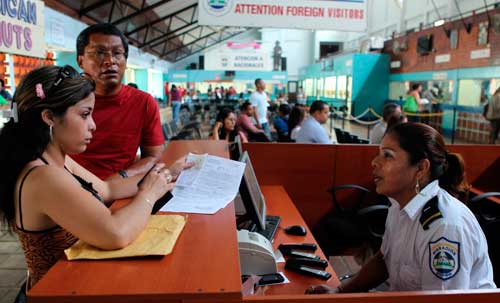Would you visit a country if you were warned to ‘exercise a high degree of caution’ because ‘armed violence’ is very common? Having lived in Nicaragua for 13 peaceful years, I haven’t given a lot of thought to the travel advice to visitors issued by Britain’s Foreign Office or by other governments. But my attention was drawn to it recently, as those of us who are ‘consular agents’ for the British embassy (which is actually based in neighbouring Costa Rica) were asked to review the advice which the Foreign Office gives on its website.
In fact, I was reasonably pleased with the UK’s advice on Nicaragua when I took a look at it. My main quibble was that the crime warnings ought to relate mainly to the capital, Managua, as other cities are relatively crime free. In fact, an index of security in Latin America published last year by Gallup showed that Nicaragua, alongside Panama, is the safest country in Latin America, despite at the same time being the second poorest. It’s in sad contrast to its immediate neighbours to the north, Honduras, El Salvador and Guatemala, which are among the most dangerous. In fact, San Pedro Sula in Honduras battles with El Salvador’s capital for the title of the world’s most dangerous city outside a war zone. So it is reasonable to expect that travellers to Nicaragua should be given the impression that it’s relatively safe, especially in contrast to some adjoining countries.
To be fair to Britain’s Foreign Office, its advice regarding Honduras is much stronger. Which country, then, believes in contrast that Nicaragua is full of ‘armed violence’? It turns out that this is Canada, whose guidance is more off-putting than even that of the United States. If anything, Australia’s is worse still, warning that ‘violent crime is common and widespread’, something which, as a resident, I have unaccountably overlooked.
Given a degree of political friction between the US and Nicaragua’s Sandinista government, it’s perhaps not surprising that the official State Department advice warns first that ‘political, economic, and social demonstrations occur frequently throughout the country’ and that they can ‘escalate into violence’. In practice, demonstrations aren’t particularly common, and as in many countries violence is rare and while it occasionally occurs, it can usually be avoided.
Even when Nicaragua was at war with the ‘Contra’ guerrillas sponsored by the United States in the 1980s, visitors could easily avoid the violence if they were careful not to travel to the war zones. However, inevitably it caused paranoia among some of those who weren’t familiar with the country. I recall in 1987 walking across the southern border using the main crossing point to enter Costa Rica, and being accosted within metres of the loose chain across the road, that marks the boundary, by a TV crew from the US. They wanted to interview me to find out ‘if it was really dangerous back there’. I suggested they cross the border to find out for themselves, and assured them they’d very likely make it back alive.
Inevitably, many people in the rest of the world, and especially perhaps those in our biggest neighbour to the north, think Nicaragua is in a state of permanent conflict. In an amusing post from the Nicaraguan city of Granada where he lives, Robert Skydell says that US friends have told him ‘Nicaragua, are you kidding? Isn’t there some kind of war going on down there?’. Skydell decided that the best response to ignorance and the US tendency to behave like an anxious parent when its citizens dare to venture abroad, is to respond with wit and a dose of sarcasm laced with truth. He therefore offers his own spoof travel advice to those irresponsible enough to contemplate a visit to the land of Uncle Sam. It begins: ‘Travellers foolish enough to visit the United States should exercise extreme caution at all times…’.


 John Perry lives in Masaya, Nicaragua where he works on
John Perry lives in Masaya, Nicaragua where he works on